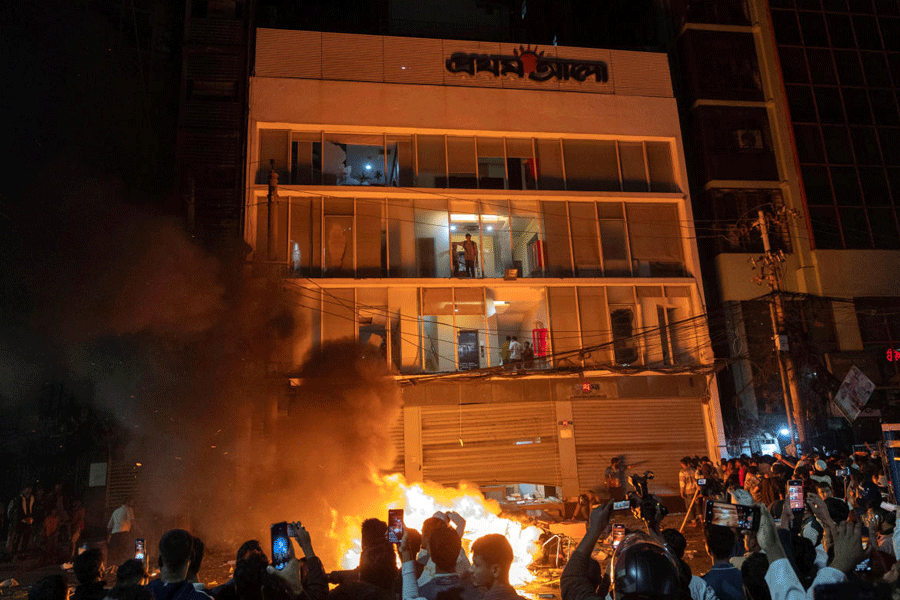Calcutta, May 23: A helicopter again searched for mountaineer Chanda Gayen around an altitude of 7,000 metres on Friday, but there wasn’t a trace of her. Expert mountaineers said only sherpas could risk their lives without batting an eyelid and a ground survey was the only hope.
Inclement weather, coupled with technical adversities, has become the stumbling block before the search operation on Yalung Kang (8,505m), also called Kanchenjunga West, where Chanda along with two sherpas — Mingma Temba and Dawa Wangchu — were hit by an avalanche and have been missing after that since around 3pm on Tuesday.
Though three sorties have already been conducted by Seven Summit Treks, a mountain tourism-based agency that organised Chanda’s expedition, rescue members could not spot the missing mountaineers due to whiteouts and blizzards.
“I’ve advised to take Tashi Sherpa along the search crew as he was at the spot of the accident,” said Basanta Singha Roy, governing body member of the West Bengal Mountaineering and Adventure Sports Foundation.
Incidentally, Tashi, who could survive the avalanche, was leading Chanda’s expedition to Kanchenjunga West. At present, he is reported to be at the base camp (5,143m).
Experts say weather becomes the most crucial factor in case of a rescue operation at higher altitude. The rescuer should possess assessment skills regarding climate, lightning, rockfall, snowstorm, avalanche and other technical adversities.
“So far air rescue is concerned, turbulence proves to be a crucial factor for a helicopter pilot. Besides, a cloudy climate often compounds his woes by reducing the visibility,” said Mingma Sherpa, managing director of Seven Summit Treks.
“Therefore, keeping in view the turbulence factor, air rescue is often carried out in the morning hours. Besides, downdrafts may also prove dangerous at a high altitude because of the reduced engine power,” he explained.
“A helicopter generally can’t fly above 6,000 metres. Therefore, in case of a rescue mission on a higher altitude, we send special helicopters. The rescue members are dropped on a surface once they locate the subjects (the trapped or missing mountaineers) and then reach them on foot,” said the veteran sherpa, who is renowned to have scaled all eight-thousanders.
Explaining how a harsh weather takes toll on a high-altitude rescue operation, he said: “The rescuers have to keep an eye on the sky to get the developments. As clouds get lower and darker, the storm is building. Besides, the rescuers have to keep a tab on its growth rate and movement.”
“We cannot rely on pre-recorded or television forecasts. We have to grasp the climate’s whimsical development and its effect on rescue operations,” he said.
Pasang Sherpa, who had climbed up to the summit camp of Yalung Kang in 2004, too, put forth some occupational hazards regarding the rescue attempt above 7,000-metre altitude.
“Lightning plays a crucial part on a high altitude rescue operation. And if it happens, the basic dangers, apart from a direct shock, lies in the path of ground currents as the electrons flow to the location of a nearby strike,” he explained.
“It’s a wrong notion to think of sherpas to be invincible just only because they have a ‘Mountain Rescue’ patch on their jacket. It requires an immense ability to sustain a long approach towards the subjects, often followed by risky and physically exhausting climbing as in case of Chanda,” said Pasang.
“The toughest part begins once a rescuer reaches the subjects,” he continued, “as now you have to carry the mountaineer to the safety zone through the dangerous terrain amid treacherous climate. A rescuer leader will control the subjects’ ascent or descent,” he said.
Sources said the rescue teams generally approached the subjects from above rather than from below as this reduced the risk of additional rock falling on the rescuer, either intentional or accidental.










